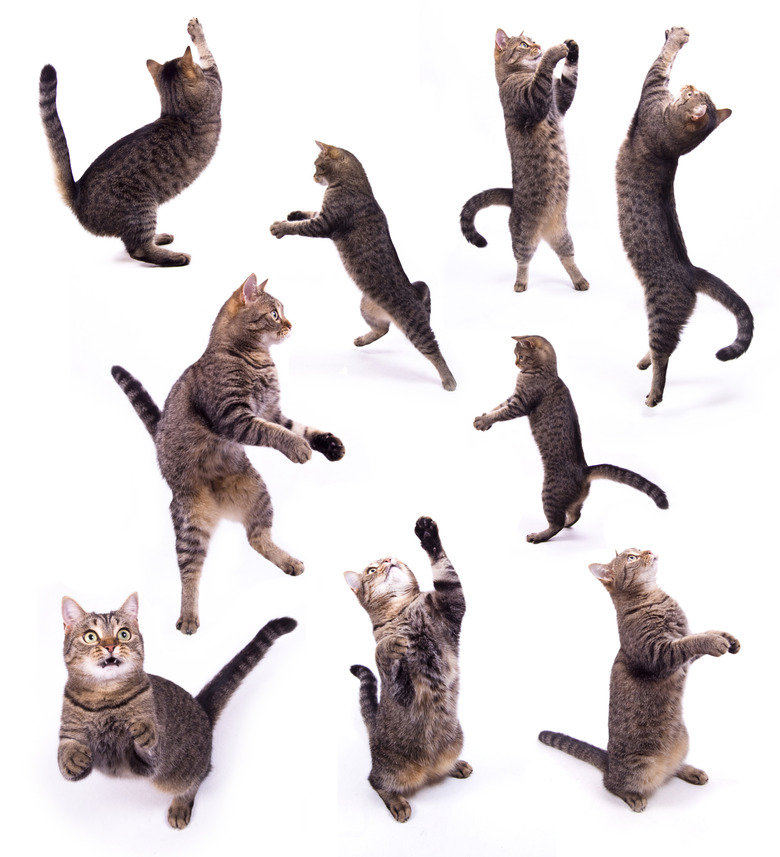Rear Leg Weakness In Cats
If your cat's rear legs seem weak — she's not able to jump, she's walking with a stiff gait or on her hocks, or she's not able to walk at all — something's amiss that requires a visit to the vet. Any number of things could be at play: She may be ill, she may have a slipped disc or tumor, or she may have ingested something harmful or experienced a traumatic injury.
Diabetic Neuropathy
Diabetic Neuropathy
Approximately 10 percent of chronically hyperglycemic diabetic cats develop the complication diabetic neuropathy, affecting the femoral nerve. If a cat has diabetic neuropathy, her hind legs become increasingly damaged as the leg's tarsal joints and nerves deteriorate, leading to numbness or pain as well as weakness and possible paralysis. It's common to see a cat walking on her hocks, or heels, if she's suffering from this condition. As her legs become increasingly weak, she won't be able to jump, and eventually she'll lose the ability to walk. Caught in the early stages, the condition can be treated — and reversed — by regulating her blood glucose concentrations.
Degenerative Joint Disease
Degenerative Joint Disease
Old age can be tough on an elderly cat's joint health. If her joints are inflamed, she has arthritis, and her joint cartilage is deteriorating and causing chronic joint inflammation, she has osteoarthritis, also referred to as degenerative joint disease, or DJD. Lameness is a common sign of DJD, along with a stiff-legged gait and difficulty with what used to be routine tasks like grooming, jumping and accessing the litter box.
DJD can be idiopathic or it can be an effect of trauma and abnormal wear on the joints and cartilage. Obesity is a factor as well, due to increased stress on the joints. DJD has no cure, but it can be managed with anti-inflammatory drugs, physical therapy and surgery.
Infectious Diseases
Infectious Diseases
A variety of infections — viral, bacterial, fungal, parasitic — can affect the spinal cord, leading to rear leg weakness in cats. Feline infectious peritonitis, or FIP, inflames the spinal cord due to an abnormal response to a coronavirus. Spinal pain and partial paralysis in two or four legs are common symptoms for this illness.
The feline leukemia virus may cause nerve damage leading to loss of motor control and rear leg weakness, which may lead to paraplegic paralysis. The rabies virus may present a variety of symptoms, though when the infection affects the spinal cord, motor control and reflexes deteriorate and paralysis progresses.
Fungal diseases, such as Cryptococcus neoformans, blastomyces and histoplasma affect the central nervous system, leading to spinal pain and partial or total paralysis. Protozoal infections including toxoplasmosis, and parasites such as verminous myelitis, may also cause spinal cord inflammation that impacts a cat's motor skills. Prognosis for regaining mobility depends on the infection. Many are not treatable.
Heart Disease
Heart Disease
Cardiovascular conditions can impact your cat's ability to use her hind legs. In the case of hypertrophic cardiomyopathy, or HCM, her left ventricle is abnormally thickened or enlarged, affecting its ability to deliver blood into the aortic valve, which distributes oxygenated blood throughout the body. Sudden rear leg paralysis may occur, in addition to loss of appetite, a weak pulse, lethargy and intolerance to exercise, and bluish discoloration of the footpads and nail beds. Various medications can help treat HCM. A low-sodium diet will help maintain a stable blood pressure.
In the case of feline aortic thromboembolism, a blood clot breaks free from a larger clot in the heart and travels through the aorta until it gets stuck in the saddle — the place where the aorta splits into the arteries to the rear legs. The blood supply is cut off, leading to a very painful condition causing hardening of the hind legs and bluish footpads. The cat's legs may also be cold; the cat may hyperventilate and cry in pain. Immediate veterinary treatment is necessary. If the cat survives, the vet may attempt to minimize the chance of recurrence with medication.
Always check with your veterinarian before changing your pet's diet, medication, or physical activity routines. This information is not a substitute for a vet's opinion.
References
- Cornell University College of Veterinary Medicine: Cornell Feline Health Center: Feline Diabetes
- PetMD: Degenerative Joint Disease in Cats
- The Merck Manual Pet Health Edition: Disorders of the Spinal Column and Cord in Cats
- PetMD: Heart Disease (Hypertrophic Cardiomyopathy) in Cats
- PetMD: Paralysis in Cats
- DVM360.com: Managing Complications in Diabetic Cats
- VeterinaryPartner.com: FATE (Feline Aortic Thromboembolism, or Saddle Thrombus)
